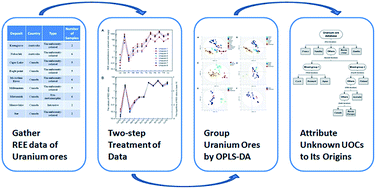Tracing origins of uranium ore concentrates (UOCs) by multidimensional statistical analysis of rare-earth impurities†
Abstract
Identifying the origins of uranium ore concentrates (UOCs) has become a research hotspot in nuclear forensics. In the present study, a novel approach using the REE data of uranium ores instead of UOC samples was established to trace the origins of unknown UOCs with the help of iterative OLPS-DA. In this paper, a database was established by gathering published REE data of uranium ores from different countries. The data were transformed by a two-step pretreatment so that they could show stronger geographical and geological indications, and the REE patterns of uranium ores could be compared with each other, as well as those of the unknown UOCs. The efficiencies of different multidimensional statistical techniques in pattern recognition, including principal component analysis (PCA), partial least squares discriminant analysis (PLS-DA) and orthogonal partial least squares discriminant analysis (OPLS-DA), were compared, and the results showed that the OPLS-DA was the most effective method when distinguishing uranium ores from different origins in the scatter diagrams. With the help of iterative OPLS-DA, samples from 10 different countries were totally distinguished within several iterations, and the discrimination orders formed a decision tree or an attribution strategy. The results indicated that it was feasible to attribute an unknown UOC to its country, deposit and type of uranium ore by comparing the unknown UOC with uranium ores from different origins according to the decision tree. Eventually, this study verifies that REE pattern is a powerful geographical and geological indicator when identifying the origin of UOC by analysing REE data of uranium ores from different origins with the help of iterative OLPS-DA, and OLPS-DA has better potential in nuclear forensics studies compared to PCA and PLS-DA, which provides support to fight against the illicit trafficking of nuclear materials.


 Please wait while we load your content...
Please wait while we load your content...